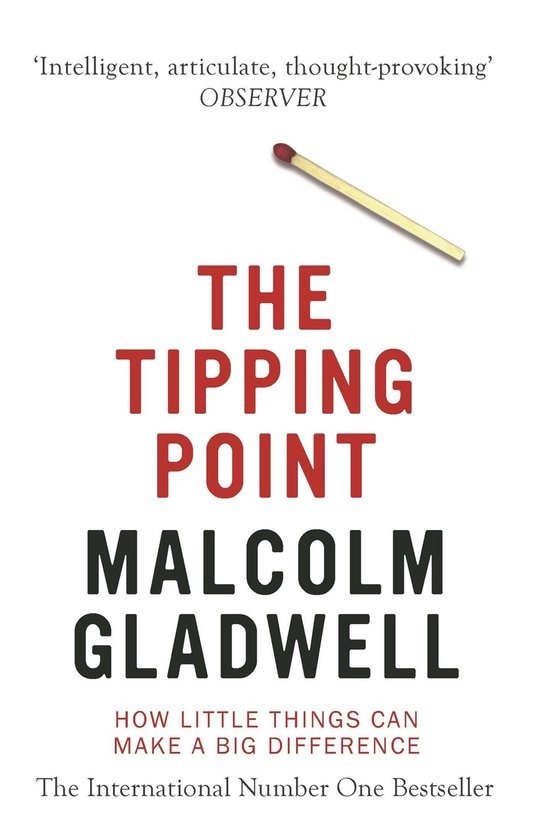In 1995, "Blue's Clues" revolutionized children's television with a radical idea: repeating the same episode five days in a row. While critics were sceptical, the show became a massive hit, with preschoolers not just watching but actively participating and learning more effectively with each viewing.
This remarkable transformation in children's educational programming lies at the heart of Malcolm Gladwell's "The Tipping Point", a book that explores how ideas and behaviours spread through society like epidemics, building quietly until they reach a critical point when everything changes at once. While the book offers compelling insights into these social transformations, it also invites us to examine critically how such changes impact different communities and social groups.
The central concept is simple but powerful: social changes behave like epidemics. They follow clear patterns, spreading quietly until they reach a critical point when everything changes at once. Gladwell presents three fundamental rules that govern these social epidemics.
Rule 1: The law of the few
Some people have an extraordinary ability to start social epidemics. Gladwell identifies three crucial types that spread new ideas through society. First come the Connectors, social specialists who know hundreds of people and link different groups together, like that friend who seems to know everyone in town. Next are the Mavens, information specialists who collect knowledge about everything from holiday destinations to house prices, and love nothing more than sharing their recommendations. Finally, there are the Salesmen, natural persuaders whose energy and charm can convince even the most reluctant people to try something new. Working together, these three groups create the perfect conditions for social epidemics to spread.
Rule 2: The stickiness factor
Messages need to be memorable to spread. Gladwell illustrates this brilliantly through "Sesame Street." The programme's creators discovered that children would learn only if specific elements appeared on screen. Adding a recurring character might double learning rates. Moving a scene three minutes earlier might triple them. These small changes made educational concepts "stick" in children's minds.
Rule 3: The power of context and its fallacies
Our behaviour changes dramatically based on our environment, but this relationship is more nuanced than it might first appear. Gladwell examines New York's transformation in the 1990s through the lens of the "broken windows" theory, which suggested that addressing minor infractions like graffiti and fare-dodging could lead to broader behavioural changes. While crime rates did fall during this period, the narrative demands deeper scrutiny.
The implementation of the "broken windows" theory under Mayor Giuliani's administration reveals the limitations of Gladwell's analysis. While the theory itself suggests a connection between environmental order and social behaviour, its practical application led to aggressive policing tactics that disproportionately affected minority communities, particularly in Black neighbourhoods. The social costs of this approach – including increased racial profiling, community tensions, and systemic over-policing – receive insufficient attention in the book's analysis.
Furthermore, the transformation of New York in the 1990s occurred within a broader economic and social context that Gladwell's framework doesn't fully address. During this period, the city experienced significant economic growth and demographic shifts. Similar crime reductions occurred in towns across America, suggesting that multiple factors beyond policing strategies contributed to urban transformation.
These rules work together in complex ways. Consider how trends spread:
The right people (Law of the Few) share a memorable message (Stickiness Factor) at the right time and place (Power of Context). This interaction becomes clear in modern examples, such as when a video goes viral on social media: popular accounts share it (Connectors), expert users explain why it matters (Mavens), and influential people convince others to watch (Salesmen). The content must be compelling (Stickiness), and it needs to arrive when people are ready for it (Context).
Final thoughts
The enduring value of this book lies in making social patterns visible, even as it invites us to think critically about their application. Written in 2000, its principles help explain everything from fashion trends to political movements, while also challenging us to consider the full complexity of social change.
For marketers, educators, or anyone interested in creating social change, these concepts offer practical tools – but they must be wielded with awareness of their limitations and potential consequences. The book's core message remains hopeful: we can create meaningful change through small, well-chosen actions. However, this change must be pursued with careful consideration of its broader social, economic, and racial implications.
Perhaps the most important lesson isn't just about creating tipping points, but about recognising our responsibility when we do. As we apply these principles – whether in marketing, public policy, or social change – we must consider not just how to make ideas spread, but how to ensure that when they do, they contribute to a more equitable and just society. The power to create social epidemics comes with the obligation to understand their full impact, especially on those whose voices might not be part of the initial conversation.
